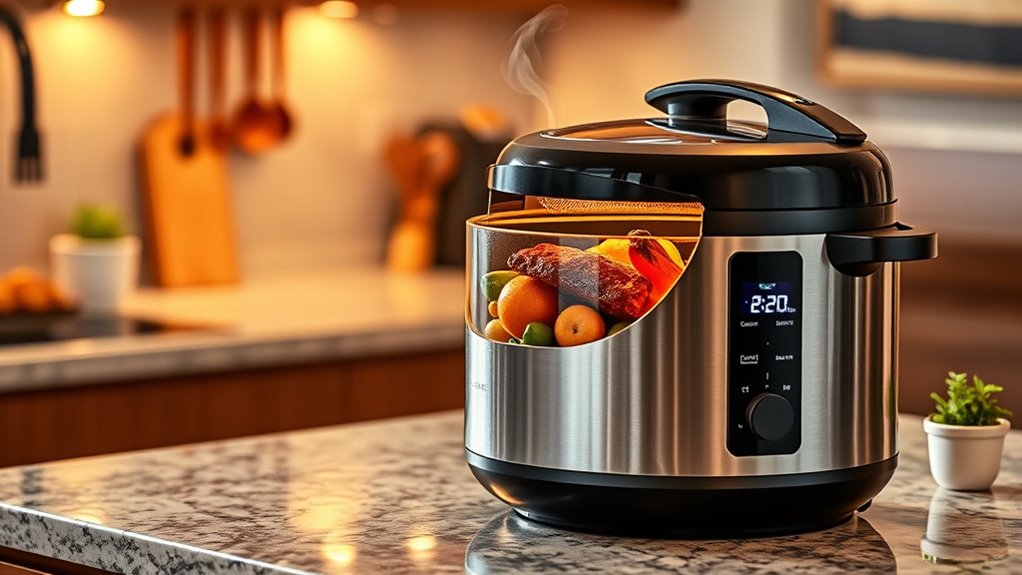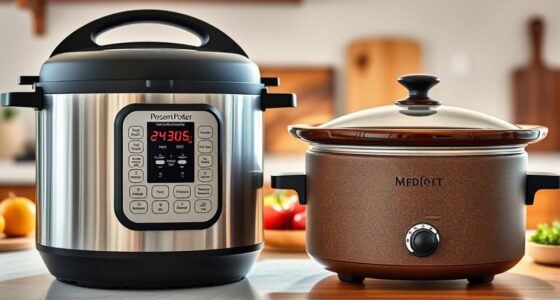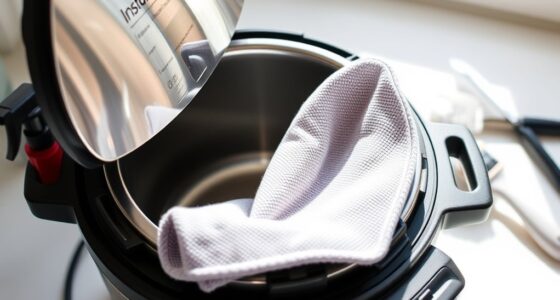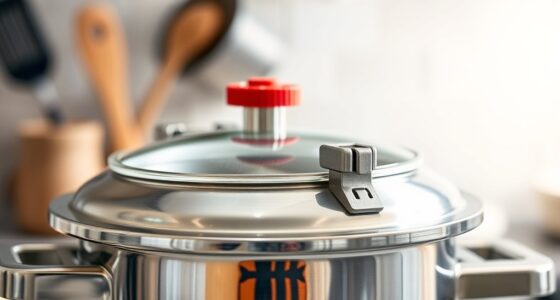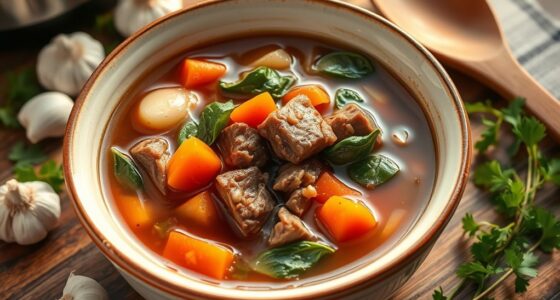Using a multicooker helps you cook energy-efficiently by combining multiple functions like pressure cooking, slow cooking, and steaming into one appliance. This reduces overall energy use and minimizes the need for multiple devices. You can customize cooking times and temperatures, ensuring thorough and safe meals while saving power. Proper handling and understanding its features maximize efficiency and safety. Keep exploring to discover how you can optimize your cooking with these versatile tools.
Key Takeaways
- Multicookers reduce energy consumption by combining multiple cooking functions into one appliance, saving electricity and gas.
- Using pressure cooking mode speeds up meal prep, decreasing overall energy use compared to traditional methods.
- Batch cooking with multicookers maximizes efficiency, allowing multiple dishes to be prepared simultaneously.
- Utilizing preset programs and timers optimizes energy use by ensuring precise cooking durations and temperatures.
- Proper ingredient handling and recipe adjustments prevent overcooking, further conserving energy and reducing waste.
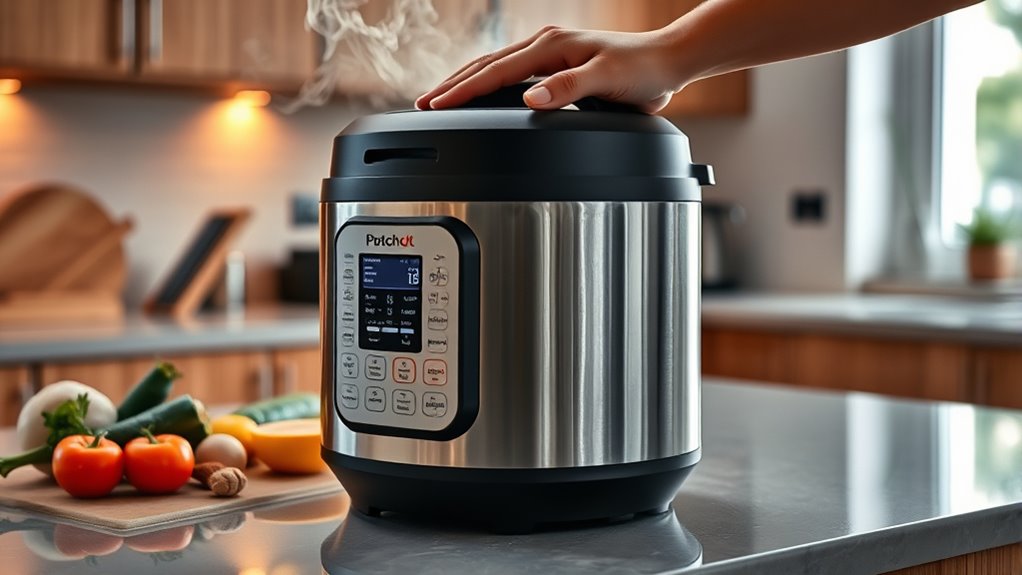
Have you ever wished for a kitchen appliance that simplifies meal preparation and saves time? Multicookers are exactly that—versatile devices that can pressure cook, slow cook, sauté, steam, and even bake. They’re a game-changer for busy households, allowing you to prepare a variety of meals with minimal effort. But beyond convenience, multicookers also promote energy efficiency, helping you cut down on electricity and gas usage. By consolidating multiple appliances into one, they reduce the need for multiple pots, pans, and stovetop time, which in turn minimizes your overall energy consumption.
Using a multicooker is straightforward, but it’s important to keep food safety in mind. Proper handling and storage of ingredients before cooking ensure you avoid cross-contamination and foodborne illnesses. The appliance’s consistent temperature control helps prevent undercooking or overcooking, which can compromise food safety. Since multicookers often have multiple functions, it’s essential to read the user manual and understand specific settings for different recipes. This knowledge guarantees you cook foods thoroughly, especially meats, poultry, and seafood, which require specific internal temperatures to be safe to eat.
Prioritize food safety by handling ingredients properly and understanding your multicooker’s settings to ensure thorough, safe cooking.
Another significant advantage of multicookers is their ability for recipe customization. Unlike traditional cooking methods, where you might be limited by conventional stovetop or oven settings, multicookers allow you to tweak cooking times, pressure levels, and heat modes with precision. Want to make a hearty stew with just the right tenderness? Adjust the pressure and cooking time accordingly. Craving a delicate rice dish or steaming vegetables? Use the dedicated steam function and set the timer to achieve your desired texture. This flexibility means you can experiment with flavors, ingredients, and techniques to suit your tastes and dietary needs.
Furthermore, multicookers often come with preset programs for specific dishes, but you’re not confined to those. You can customize recipes by combining different functions—like browning meat first and then switching to slow cook mode—so your dishes turn out exactly how you want. This level of recipe customization empowers you to be more creative in the kitchen while maintaining control over the process. Plus, many models include timers and delay start options, giving you the ability to set up meals in advance, which enhances convenience for busy mornings or dinner preparations.
In short, multicookers are not only energy-efficient but also adaptable tools that prioritize food safety and allow for personalized cooking experiences. They help you prepare nutritious, safe meals quickly and comfortably, all while reducing your appliance footprint and energy use. With a little practice, you’ll discover how to tailor each recipe to your preferences, making every meal a perfect blend of flavor, safety, and efficiency.
Frequently Asked Questions
How Do Multicookers Compare to Traditional Stoves in Energy Use?
Multicookers use less power than traditional stoves, making them more energy-efficient. They have lower power consumption because they cook food faster and retain heat better, which leads to significant energy savings. When you use a multicooker, you’re not only saving on electricity but also reducing cooking time. This efficiency helps you cut down on energy bills while still preparing delicious meals quickly and conveniently.
Can Multicookers Replace All Cooking Appliances in My Kitchen?
Think of your kitchen as a symphony, and multicookers as the conductor. While they excel at many tasks, they can’t replace every kitchen appliance. Alternative cooking methods like stovetops or ovens still have their place, and integrating multicookers with other appliances creates a harmonious workflow. You’ll still need a blender, toaster, or microwave for specific tasks, but multicookers can simplify and energy-optimize much of your cooking routine.
Are There Safety Concerns With Using Multicookers Regularly?
Yes, there are safety concerns with regular multicooker use. You should watch out for electrical hazards, like damaged cords or plugs, which could cause shocks or fires. Overheating risks are also present if you don’t follow the manufacturer’s instructions or if the appliance malfunctions. Always keep the cooker clean, use it on stable surfaces, and unplug it when not in use to minimize these dangers and guarantee safe cooking.
How Do I Choose the Most Energy-Efficient Multicooker Model?
Picking the right multicooker is like choosing a fuel-efficient car. You want a model with low energy consumption that still offers useful features. Look for energy-efficient labels, adjustable temperature controls, and smart timers to save power. Compare models based on their features, reviews, and energy ratings. This way, you’ll find a device that cooks well without wasting electricity, helping you save money and protect the environment.
What Maintenance Is Required to Keep Multicookers Energy-Efficient?
To keep your multicooker energy-efficient, you should follow regular cleaning routines and component checks. Clean the inner pot, lid, and seals to prevent buildup that can cause overheating. Check the heating element and electrical connections for any signs of wear or damage. By maintaining these parts, you guarantee the multicooker operates smoothly, conserving energy and extending its lifespan. Proper maintenance ultimately helps you save on electricity and keeps your appliance working efficiently.
Conclusion
Imagine the warm steam rising as your multicooker works quietly, transforming raw ingredients into a delicious meal. You save energy and time, all while filling your home with irresistible aromas. With each press of a button, you step into a world where convenience meets eco-friendliness. So, embrace your multicooker, and let it become your trusty kitchen companion—turning simple ingredients into cozy, nourishing dishes that make every mealtime feel special.
